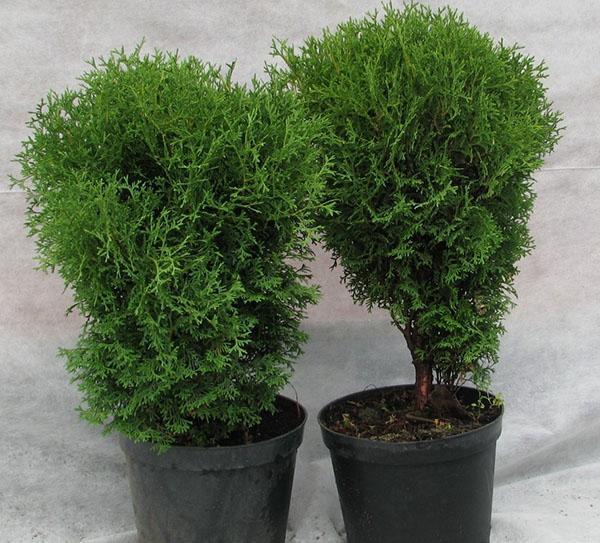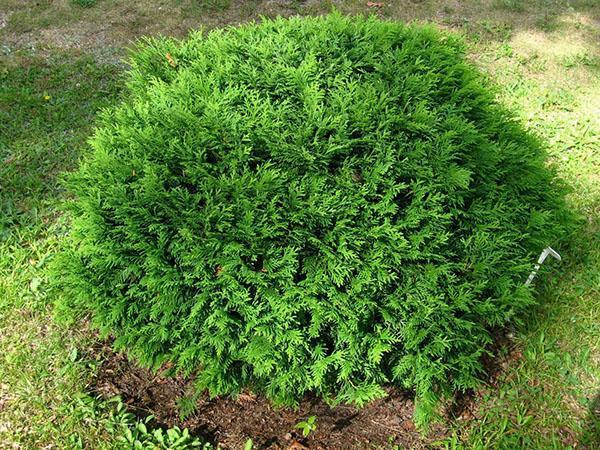A special place in the landscape design of thuja Hoseri
 Small thuja Western ones with a spherical crown are unpretentious, easy to care for and appropriate in the design of large and very modest areas. Therefore, their varieties, including thuja Hozeri, are so popular.
Small thuja Western ones with a spherical crown are unpretentious, easy to care for and appropriate in the design of large and very modest areas. Therefore, their varieties, including thuja Hozeri, are so popular.
Thuja western takes first place in the list of the most popular decorative conifers. Today, varieties with different crown shapes and needles color are used for landscaping. Some plants retain their appearance throughout the year, while the color of the branches depends on the season.
Description of Tui Hoseri

The dark green crown in summer turns into reddish-brown, bronze tones by autumn. But this does not mean that in winter the shrub will lose its attractiveness. The needles do not fall off, and the thuja is only going through a period of rest. In spring, the green tint returns again The needles, like the shoots, tolerate winter well, and die off and fall off only three years after they appear.
A frost-resistant plant does well in the middle lane. According to the description, thuja Hoseri:
- only in the first years of life does it need additional shelter;
- tolerates pruning without problems;
- thanks to its large compact crown, it is not afraid of strong winds.
Thuja is durable and can decorate the site for several decades. By the age of 10, the diameter and height of the shrub reaches 60–80 cm.
 In the future, growth slows down even more. Since the annual growth is very small, the crown perfectly retains its natural shape, and the owner of the plot saves time on cutting the thuja Hoseri.
In the future, growth slows down even more. Since the annual growth is very small, the crown perfectly retains its natural shape, and the owner of the plot saves time on cutting the thuja Hoseri.
However, when thinking about planting this variety, you need to remember that for thuja you need loose, moderately fertile soil and regular watering.
If the soil under the bush dries up, both the underground part and the crown of the thuja suffer from a lack of moisture. The plant loses its tone, the needles begin to turn yellow, young shoots can fade.
 In the description of thuja Hoseri it is indicated that the plant is shade-tolerant, it can grow under the crowns garden trees, buildings, large bushes. However, for the ephedra of this variety, it is better to choose a well-lit area or partial shade. Here culture will show its best features:
In the description of thuja Hoseri it is indicated that the plant is shade-tolerant, it can grow under the crowns garden trees, buildings, large bushes. However, for the ephedra of this variety, it is better to choose a well-lit area or partial shade. Here culture will show its best features:
- density and roundness of the fluffy crown;
- rich color of needles.
Planting thuja Hoseri and caring for the shrub
 Thuja is planted in early spring or autumn so that the shrub has time to take root before frost. In the northern regions, it is important not to be late with planting the plant, otherwise the root system will freeze out, and the thuja Hoseri will die.
Thuja is planted in early spring or autumn so that the shrub has time to take root before frost. In the northern regions, it is important not to be late with planting the plant, otherwise the root system will freeze out, and the thuja Hoseri will die.
Tui, like all conifers, do not tolerate stagnant moisture and deep shade. Plants gradually lose their attractiveness in the shade.
If the site is in a flooded area, artificial hills are made for planting, drainage channels are laid, a layer of sand, expanded clay, broken brick is poured at the bottom of the planting pits.
The plant has no special requirements for the composition and acidity of the soil. A pit 60 to 80 cm deep is made for a 3-4 year old seedling. The young thuja is placed in the hole so that the root collar is not covered with soil. The free space between the roots and walls of the hole is filled with a substrate. It is better to prepare it in advance by mixing:
- 2 pieces of garden land;
- 1 part sand;
- 1 part lowland peat.
Fresh organic, which can burn the root system of the seedling, is not poured under the thuja, but a complex mixture for conifers will help thuja to take root and overcome the acclimatization period faster.
Until young branches appear on the bush, they water the thuja as soon as the surface of the trunk circle dries up.
In the future, watering is carried out weekly at the rate of 8-10 liters per shrub. Water is especially important in drought. To keep it in the soil, spend mulching... And the good condition of the crown is maintained with the help of sprinkling.
 Caring for the Hoseri thuja after planting includes spring and autumn dressings. At the beginning of the growing season, fertilizers help the plant to wake up, recover and grow. In the fall, potassium salts and phosphates, together with abundant pre-winter watering, lay the foundation for a successful wintering. Before the onset of cold weather, young shrubs are tied and covered with spruce branches, non-woven material. Cover the crown with snow.
Caring for the Hoseri thuja after planting includes spring and autumn dressings. At the beginning of the growing season, fertilizers help the plant to wake up, recover and grow. In the fall, potassium salts and phosphates, together with abundant pre-winter watering, lay the foundation for a successful wintering. Before the onset of cold weather, young shrubs are tied and covered with spruce branches, non-woven material. Cover the crown with snow.
In spring, sanitary pruning is carried out, and the soil under the plant is carefully loosened, not deepening more than 7-10 cm.
Thuja Hoseri in landscape design
 Thuja of a low-growing variety is a universal plant. Thanks to its shade tolerance, the shrub will revive the lower tier of the garden, it will not get lost under the walls of a residential building and near the fence of the site.
Thuja of a low-growing variety is a universal plant. Thanks to its shade tolerance, the shrub will revive the lower tier of the garden, it will not get lost under the walls of a residential building and near the fence of the site.
In landscape design, thuja Hoseri is widely used to grow living borders, as bright accents on spacious lawns, and also as visual support for tall, herbaceous plants: flowers, ferns, cereals.
Thuja Hoseri is excellent for growing in containers used for landscaping balconies, loggias, roofs, verandas.
An excellent background for thuja will be decorative deciduous and flowering shrubs, for example, viburnum, spirea, garden barberry or turf. Planting ground cover species in front of the thuja will create on the flower bed the effect of a variegated carpet with bright spots of conifers.